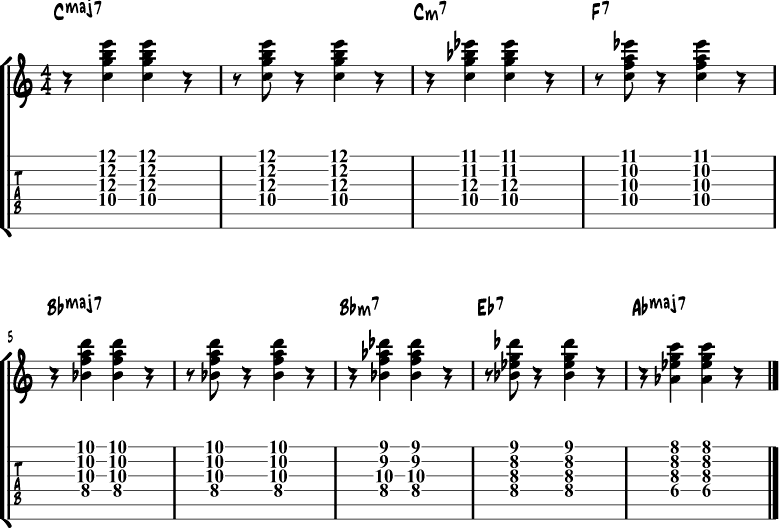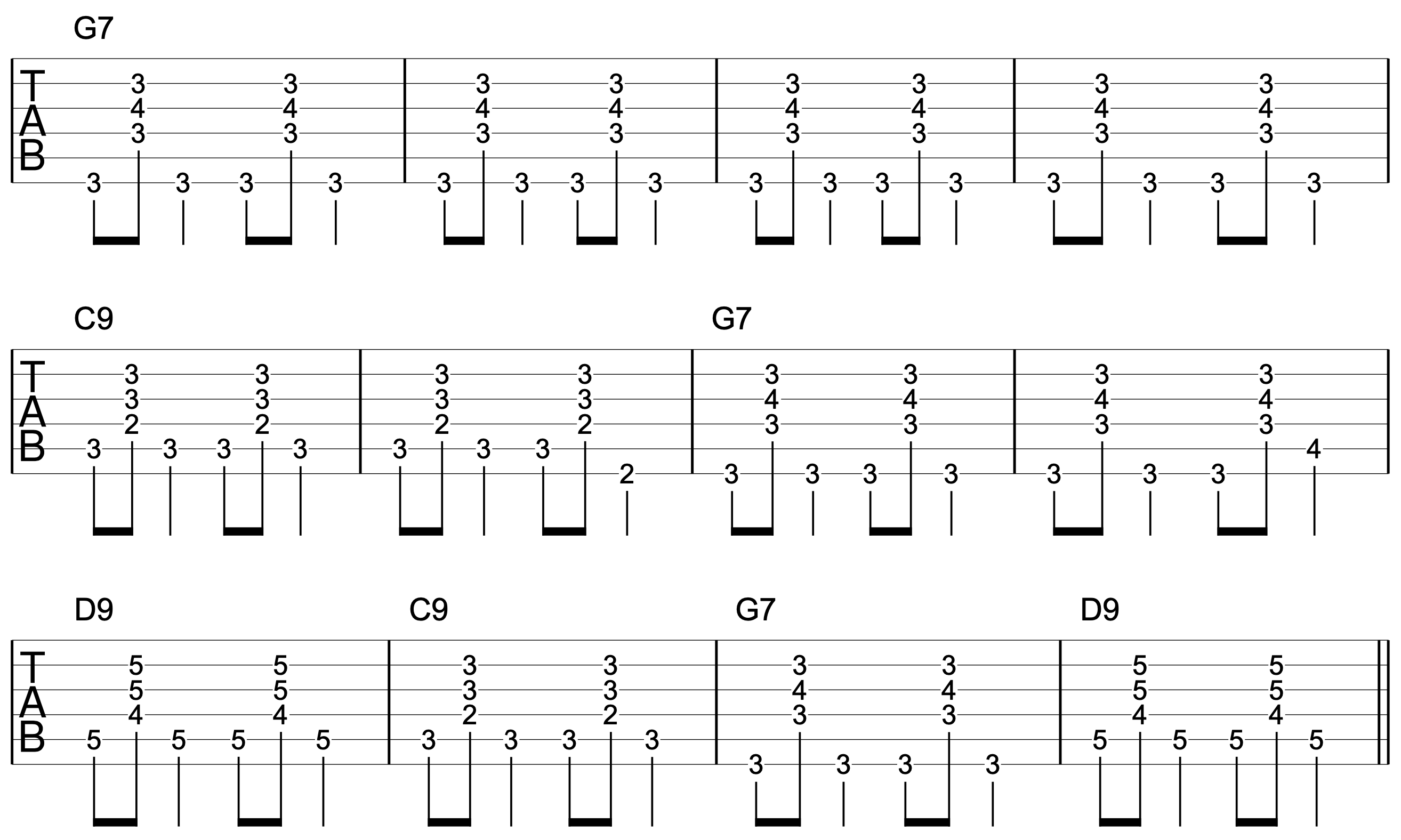Jazz Chord Progressions: Unlock Musical Creativity
You’re about to uncover the magic that makes jazz music so enchanting: jazz chord progressions. Imagine being able to play or appreciate jazz with a deeper understanding of what makes it tick.
Whether you’re a budding musician or a passionate listener, knowing these progressions can transform your experience. Picture yourself impressing friends with your knowledge or even creating your own jazz pieces. As you explore this article, you’ll discover the building blocks of jazz music and how they create the rich, emotive sounds you love.
Ready to dive in and elevate your jazz game? Let’s get started!

Credit: www.jazzguitar.be
Jazz Chord Progressions
Jazz chord progressions are the foundation of jazz music’s rich sound. They define the structure and mood of a jazz piece. Musicians use them to express emotions and creativity. These progressions can be complex or simple, offering endless possibilities. Understanding jazz chord progressions opens up a world of musical exploration.
Table of Contents
ToggleHistorical Roots
Jazz chord progressions have deep historical roots. They evolved from blues and ragtime music in the early 20th century. African American communities shaped the unique sound of jazz. European classical influences also played a role. These roots created a diverse musical landscape. Jazz music grew and spread across the world.
Key Elements
Key elements define jazz chord progressions. They often include dominant seventh chords. These chords create tension and release. Extensions like ninths and thirteenths add richness. The ii-V-I progression is a staple in jazz. It provides a smooth transition between chords. Chromaticism enhances the complexity and beauty of jazz music.

Credit: acousticguitarlessonsonline.net
Types Of Jazz Chord Progressions
Jazz is a musical genre full of rich harmonies and rhythms. Understanding its chord progressions is key to appreciating its complexity. Different types offer unique flavors. They range from joyful major progressions to melancholic minor ones. They also include mysterious modal progressions. Each type brings its own mood and style. Let’s explore them further.
Major Progressions
Major chord progressions in jazz are bright and uplifting. They often include the I-IV-V pattern. This progression is common and easy to follow. It creates a happy and optimistic sound. Jazz musicians use it in many upbeat tunes. It sets a positive tone and often leads songs forward.
Minor Progressions
Minor chord progressions create a sadder, deeper sound. They often include the i-iv-v pattern. This progression adds emotion and depth to music. It is used in blues and ballads. It evokes feelings of longing and introspection. Jazz artists use it to tell emotional stories through music.
Modal Progressions
Modal progressions are unique to jazz. They rely on modes rather than traditional scales. This gives them a mysterious and complex sound. Modal progressions often shift moods unexpectedly. They provide a canvas for improvisation. Musicians explore new melodies and rhythms within these progressions.
The Role Of Improvisation
Jazz chord progressions often serve as a canvas for musicians. Improvisation plays a crucial role in painting this canvas with unique musical colors. Each musician brings personal flair and creativity, crafting unforgettable melodies. This spontaneous expression is what makes jazz vibrant and alive.
Spontaneity And Expression
Improvisation in jazz is about freedom. Musicians express their emotions and ideas through spontaneous melodies. It’s like speaking through music, conveying feelings without words. This makes each performance unique and personal.
Being spontaneous requires courage. Musicians trust their instincts and let their creativity flow. They listen to the mood and respond with musical phrases. It’s a conversation, not just a solo act.
Techniques For Improvisation
Successful improvisation comes from practice and understanding jazz theory. Musicians study scales, chords, and rhythm patterns. This knowledge helps them create harmonies and melodies on the spot.
Listening is key. Musicians tune into their bandmates, reacting to changes in the music. This interaction creates a dynamic performance. Using licks and riffs is common too. These are short, catchy phrases that fit various chord progressions.
Experimentation is encouraged. Trying new ideas and sounds keeps the music fresh. Musicians explore different styles and influences, expanding their improvisation skills.
Popular Jazz Standards
Jazz standards are the backbone of jazz music. These timeless pieces hold immense significance for musicians. They serve as a foundation for improvisation. Jazz chord progressions within these standards are unique and captivating. They offer rich harmonic textures and endless creative possibilities.
Timeless Classics
Timeless classics feature jazz standards that have stood the test of time. “Autumn Leaves” is one such piece. It has a haunting melody and beautiful chord progressions. “All the Things You Are” enchants with its complex harmonies. Both pieces provide a rich canvas for improvisation.
“Blue Monk” is another classic with a memorable bluesy feel. Its simple yet effective progression draws musicians and audiences alike. These classics shape the core of jazz performances worldwide.
Modern Interpretations
Modern interpretations breathe new life into traditional jazz standards. Musicians experiment with fresh chord progressions and rhythms. They infuse elements from different genres. This results in exciting and innovative renditions.
Brad Mehldau’s take on “Blackbird” by The Beatles showcases this creativity. His jazz version transforms the original into something unique. Similarly, Esperanza Spalding’s interpretations blend jazz with contemporary sounds. These modern interpretations keep jazz vibrant and evolving.
Learning And Practicing Jazz Progressions
Jazz chord progressions are the backbone of jazz music. They shape the melody and feel of a piece. Learning these progressions opens a world of musical expression. Practicing them builds your skills and confidence. Dive into the rhythms and harmonies that define jazz. Experience the joy of creating your own musical stories.
Effective Practice Strategies
Set clear goals before each practice session. Focus on one progression at a time. Play slowly to understand each chord’s sound and function. Use a metronome to keep a steady rhythm. Record your practice sessions to track your progress. Listen to jazz recordings to hear progressions in real music. Imitate the phrasing and timing of your favorite players. Create a regular practice schedule to build consistency.
Common Mistakes To Avoid
Many players rush through progressions without understanding them. Avoid this by taking your time. Don’t ignore the importance of rhythm. It’s as vital as the chords themselves. Avoid playing without a plan. This can lead to unfocused practice. Don’t skip recording your sessions. Listening back helps identify areas for improvement. Avoid comparing your progress to others. Everyone learns at their own pace.
Influence On Other Music Genres
Jazz chord progressions have a unique ability to transcend their genre boundaries, influencing various music styles with their complexity and emotional depth. They are not just the backbone of jazz; they have seeped into pop, rock, and even classical music. As you explore these progressions, you’ll find them enhancing melodies and creating unexpected harmonies in genres you might not expect.
Crossover Into Pop And Rock
Jazz chord progressions have made notable appearances in pop and rock music. Think of artists like Radiohead and Steely Dan. They use rich, unexpected chords to add depth to their songs.
These progressions can change a simple melody into something profound. If you play guitar or piano, try adding a jazz chord to your favorite pop song. You’ll notice a fresh twist in the music.
Why do pop and rock musicians embrace jazz chords? They offer a way to stand out and surprise listeners. Could your favorite track be hiding a jazz progression?
Impact On Classical Music
Classical music, known for its structured compositions, has also felt the influence of jazz. Composers like Gershwin have blended jazz elements with classical forms, creating masterpieces.
Jazz chord progressions bring a new layer of expressiveness to classical music. They break the mold, offering a sense of spontaneity that classical music traditionally lacks.
Imagine listening to a symphony and suddenly hearing a jazzy twist. It challenges your expectations and adds excitement. How might jazz progressions change your view of classical pieces?
Creating Original Jazz Progressions
Creating original jazz chord progressions requires creativity and understanding. Jazz is a genre that thrives on improvisation and innovation. Musicians often experiment with chord progressions to create unique sounds. The balance between tradition and modernity plays a crucial role. Musicians develop their distinct style while paying homage to jazz’s rich history.
Innovative Techniques
Exploration is key in jazz. Experiment with altering traditional chords. This creates unexpected sounds and keeps listeners engaged. Try substituting a major chord with a minor. Or add an augmented chord to a typical progression. Use dissonance to add tension and drama. Consider incorporating modal interchange. It brings fresh harmonies from different scales. These techniques can transform a simple progression into something memorable.
Balancing Tradition And Modernity
Jazz has a rich history. Many musicians draw inspiration from its roots. Yet, modern jazz also embraces new ideas. Balance these aspects by blending classic and contemporary chords. Use traditional progressions as a foundation. Build upon them with modern variations. This fusion keeps the music accessible and fresh. It respects the past while pushing boundaries. Finding this balance helps create original jazz progressions that captivate audiences.

Credit: m.youtube.com
Frequently Asked Questions
What Is The Best Chord Progression For Jazz?
The ii-V-I progression is the most popular chord progression in jazz. It consists of the second, fifth, and first scale degrees. This progression creates smooth transitions and rich harmonies, making it a favorite among jazz musicians. Experimenting with variations can add unique flair to your jazz compositions.
What Is The 2 5 1 Progression In Jazz?
The 2-5-1 progression is a common jazz chord sequence. It involves the second, fifth, and first chords of a key. Typically, it uses minor, dominant, and major chords. Musicians often use it to create smooth transitions and resolve tension in compositions or improvisations.
What Is The 1 6 2 5 Chord Progression?
The 1 6 2 5 chord progression is a sequence often used in jazz music. It includes the I, VI, II, and V chords. In the key of C major, these chords are C, Am, Dm, and G. This progression creates a pleasing cyclical sound.
Is Jazz Just 7th Chords?
Jazz is not just 7th chords. It uses various chord structures, including 9ths, 11ths, and 13ths. Jazz musicians often incorporate complex harmonies and improvisation. Rhythms and melodies are integral parts of jazz, making it a rich and diverse genre beyond simple chord use.
Conclusion
Jazz chord progressions bring music to life. They add depth and emotion. Musicians can explore endless creative possibilities. Understanding these progressions enhances musical expression. It makes playing jazz more enjoyable. Experiment with different chord combinations. Listen to jazz legends for inspiration.
Practice regularly to improve your skills. Gradually, your confidence will grow. Jazz is a journey, not a destination. So, enjoy every moment of learning. Embrace the rhythm and harmony. Let the music guide your soul. Keep playing, keep exploring. Jazz awaits your personal touch.
